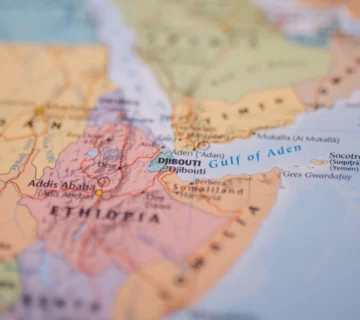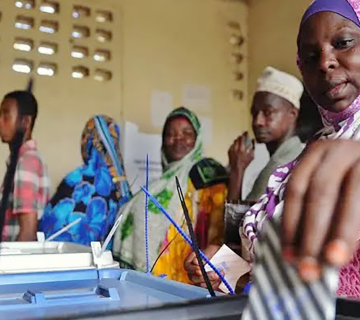The cost of living has been rising in Kenya in recent times. Economists and humanitarian crisis experts have explained this in terms of the growing demand for scarce commodities and weak purchasing power resulting from, inter alia, the Russia-Ukraine war; poor post-COVID-19 recovery; climate change; weakened economy; and runaway public spending. Regardless, public sentiment about the rise is divided, and there is a general consensus that the masses (common people) are struggling to meet their basic needs. Unsurprisingly, the economy is a key campaign issue and central pillar of political elites’ manifestos. So far, and on the backdrop of the KES 20.6 billion allocated to the economic stimulus program in the 2022/2023 budget and USD 4 million UN-donated emergency funds), presidential hopefuls have offered three approaches to stimulate Kenya’s economy focused on either: two sectors; small, informal businesses (‘hustler’); and several sectors (multisector). The jury on the most appropriate economic proposal is still out, but it will serve the electorate well in the period immediately after the election, and long term, to choose the approach that has the highest potential to stimulate and grow the country’s economy and lift Kenya’s ‘bottom millions’ out of poverty quickly and sustainably. Short of this, Kenya’s economy will remain vulnerable to political, and environmental shocks, and an already bad situation will worsen.
Returning to the Basics
Currently, food insecurity is a national emergency. Thus, the most appropriate economic approach for Kenya at this juncture needs to be centered on increased agricultural production, for two main related reasons. First, most Kenyans earn their income by producing or trading in agricultural or related products (such as produce, seeds, farming implements, and fertilizer) and systems (land, for example). In other words, Kenya’s economy depends on it the most. Secondly, increased food production will likely increase the amount and variety of available food, improving access to food, and reducing food insecurity. This will alleviate the suffering of millions.
The Root’s Party has suggested the production of cannabis Sativa (hemp or marijuana) and snake poison to create new value chains for additional jobs and revenue streams that will help reduce youth unemployment and Kenya’s runaway debt. Rallying Kenyans behind the establishment of hemp and snake farms in the country is an unconventional and fresh take on agricultural production. It, for instance, challenges popular attitudes toward snakes as dangerous wild ‘animals’ rather than farm ‘animals.’ It also invites Kenyans to explore alternatives to coffee, tea, and tourism. The inherent ideas of quick money and solving the snakebite problem in locations such as Kabarnet, Kapenguria, Kitui, and Makueni – have cross-generational appeal, but it is difficult to implement this two-sectors approach in the short term. First, as the lines between industrial (medicinal) hemp and recreational (psychoactive) hemp can be blurred easily, the hemp ecosystem is highly regulated and susceptible to black markets. Thus, producing and marketing hemp for national revenue can quickly become Herculean tasks. Moreover, the potential of hemp abuse and venomous snakes to cause physical and mental harm is high. Further, farming multi-product snakes for snake poison only makes partial sense as farmed snakes will require feeding, professional handling, and the safe habitation support of the Kenya Wildlife Service. As with marijuana, a robust plan, mass education, public buy-in, and monetary investments are needed to build and manage the underdeveloped snake value chain. It will take some time to engineer the shift of Kenyans’ psyche to accommodate this expanded definition of agriculture. When it comes down to it, the choice between feeding multi-product reptiles for only one product and feeding the populace in a cash-strapped, food-scarce environment is a no-brainer.
To improve food security and (re)create sustainable livelihoods, the Azimio La Umoja party proposes targeting all Kenyans, making multisector investments – including in manufacturing, and education – and giving ‘needy’ families KES 6,000 monthly. Food security and sustainable income appeal to Kenyans of all stripes. This model’s biggest undoing is that its track record is unimpressive; it is dependent on a diminishing tax payers base and limited revenue; and requires time to implement. Further, in post-pandemic Kenya, ‘needy’ is open to many varied interpretations, and abuse. Defining the boundaries of this category across social classes and within a specific demographic will be a nightmare.
Kenya Kwanza party’s approach to stimulating the economy will focus on ‘Kenya’s bottom millions’ – also known as hustlers (individuals engaged in small and informal businesses with supposedly limited income). These include mama mbogas, boda boda riders, and roadside car washers. This approach will entail reviving collapsed sugar and paper industries, and providing all new, ‘needy’ mothers with single-use diapers. This model faces three main challenges. First, hustler elevation, which suggests the overlooking of non-hustlers, mutually excludes the idea of all Kenyans. Next, in Kenya’s class society, the appeal of the hustler narrative is mixed and limited – because hustlers contribute minimally to Kenya’s tax basket; rich people also refer to themselves as hustlers; and millions commonly work multiple jobs for a hand-to-mouth existence. Lastly, this model is blind to the needs of Kenya’s largest demographic, individuals aged under 34 years. This demographic is more interested in the digital ecosystem that spans internet-enabled information and communication technologies, digital currencies, and online trading than farming sugarcane and producing paper. With a debt of about KES 10 trillion, and a shrinking taxpayer base, reinvesting billions in these industries is thus nostalgic, myopic, and backwards-looking, and unlikely to stimulate or sustain Kenya’s economy.
Reducing Hunger, Increasing Income
Kenya’s economic growth can be kick-started and buttressed with some adjustments to the proposed approaches; a mix of aspects of the proposed models; or an entirely new one. “[We] the people …” for instance, can leverage their Constitutional authority and demand an entirely new, people-driven, class-transcending model. Such a model would address food insecurity and sustainable income generation concurrently; head-on; and in an inclusive, creative, and harmless manner. The incoming government should expand the tax base beyond the overburdened middle class to include hustlers (formal and informal, online and offline) and high-income earners whose tax contribution is not reflective of their comparatively large income. This elimination of tax biases should be accompanied by reducing wasteful public spending and corruption. The collected revenue should be used to feed hungry Kenyans and build the country’s food reserves by improving land tenure systems, policies, and practices to enable mass food production, and trading. As hunger reduces and incomes stabilize and/or increase, the government could rethink agriculture by experimenting with high-value, low-input crops and animals. This should be done following wide public-private sector consultations and the participation of Kenyans, on a phased, pilot bases. Ultimately, Kenyans want and desire to participate in a growing, non-repressive economy. There is still room – in the remaining 38 days – for more, sustained economic debates and discussions. These must continue.
Roselyne Omondi is the Associate Director, Research, at the HORN Institute
Photo: Kenya Central Bank Governor Patrick Njoroge displays the newly designed Kenyan shilling bank notes during a news conference at the Central Bank in Nairobi, Kenya, June 3, 2019 (Photo Credit: Reuters/Baz Ratner)
The contents of this article are copyright of © The HORN Institute 2022. All rights reserved. Any redistribution or reproduction of part or all of the contents in any form and for whatever reason is prohibited. You may use the content of this article for personal reasons, but acknowledge the author and cite the website as sources of the material.



